|
OVER
FISHING
ABOUT -
HOME - WHALING - A-Z INDEX
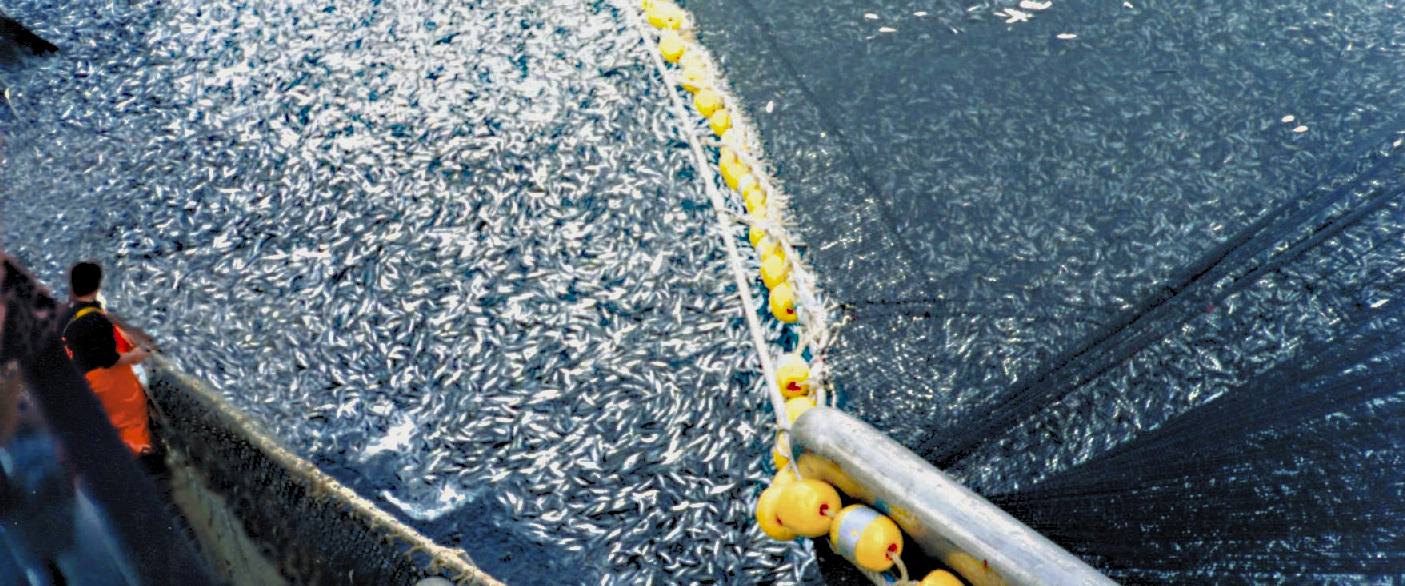
JUST
PLAIN GREEDY - 400 tons of jack mackerel caught by a Chilean purse seiner.
These fishing boats use nets that surround the fish on the
sides and underneath. The good news is that from the look of
this haul there is not so much bycatch.
In
an effort to feed a growing population we are plundering the
ocean depths with giant trawler nets causing serious damage to ocean ecology and wild
fish stocks. We must regulate industrial scale fishing by
imposing serious financial penalties and boat confiscations if
that is the only way to prevent unauthorized catches. Diesel
subsidies for large trawlers should be banned and fines
imposed for damage to the seabed.
REUTERS 26 JUNE 2017
Fishing fleets dump about 10 percent of the fish they catch back into the ocean in an "enormous waste" of low-value fish despite some progress in limiting discards in recent years, scientists said on Monday.
A decade-long study, the first global review since 2005 and based on work by 300 experts, said the rate of discards was still high despite a decline from a peak in the late 1980s. Discarded fish are usually dead or dying.
Almost 10 million tonnes of about 100 million tonnes of fish caught annually in the past decade were thrown back into the sea, according to the "Sea Around Us" review by the University of British Columbia and the University of Western Australia.
Industrial fleets often throw back fish that are damaged, diseased, too small or of an unwanted species. A trawler with a quota only to catch North Atlantic cod, for instance, may throw back hake caught in the same net.
Discards are an "enormous waste ... especially at a time when wild capture fisheries are under global strain amidst growing demands for food security and human nutritional health," they wrote in the journal Fish & Fisheries.
The report welcomed the decline in discards from a peak of about 19 million tonnes in 1989, roughly 15 percent of a total catch of 130 million tonnes.
The fall may be linked to restrictions in some nations on discards and improved fishing gear. Also, a rise in the price of fishmeal for aquaculture made it profitable to keep formerly low-value species, it said.
But it might just reflect a lack of fish.
"We suspect that (the decline) is because overfishing ... has already depleted the species being discarded," lead author Dirk Zeller of the University of Western Australia told Reuters.
Few fish survive getting thrown back although some species such as sharks, rays or crustaceans are more resilient.
The U.N.'s Food and Agriculture Organization last estimated, in 2005, that eight percent of fish were discarded from 1992-2001. Those numbers, using different methods, are not directly comparable with the Sea Around Us data.
The scientists said discards were now highest in the Pacific, a shift from the Atlantic.
Russian fleets, for instance, discarded large amounts of Alaska pollock in the North West Pacific because they only wanted the roe. Fleets from
South
Korea, Taiwan and China were also among those dumping Pacific fish.
By Alister Doyle,
OSLO
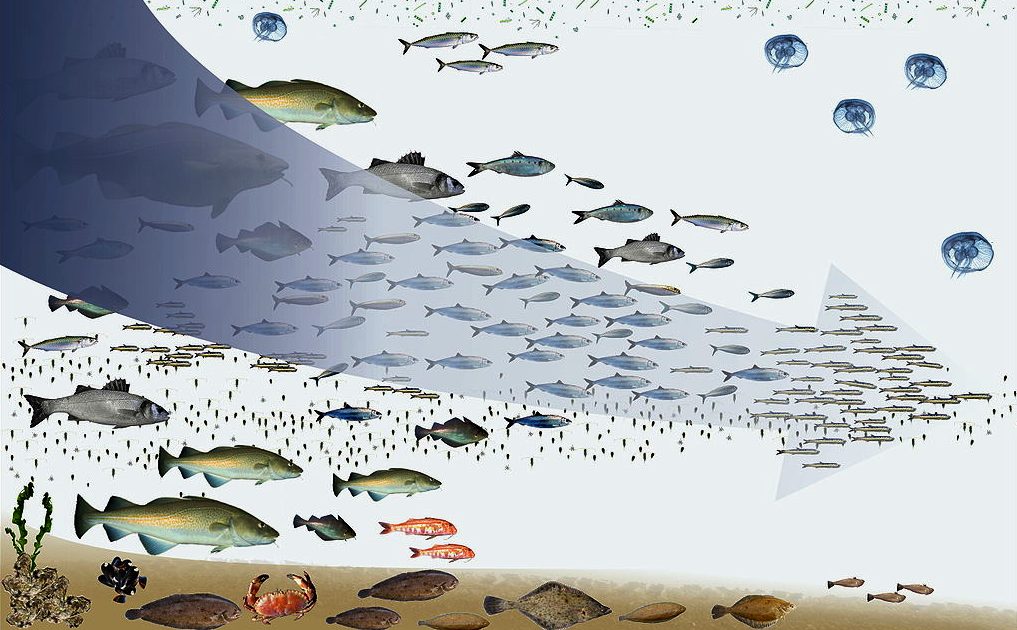
FISHING
DOWN THE FOOD CHAIN - Fishing down the food web is the process whereby fisheries in a given ecosystem, "having depleted the large predatory fish on top of the food web, turn to increasingly smaller species, finally ending up with previously spurned small fish and invertebrates."
The process was first demonstrated by the fisheries scientist Daniel Pauly and others in an article published in the journal Science in 1998. Large predator fish with higher trophic levels have been depleted in wild fisheries. As a result, the fishing industry has been systematically "fishing down the food web", targeting fish species at progressively decreasing trophic levels.
The trophic level of a fish is the position it occupies on the food chain. The article establishes the importance of the mean trophic level of fisheries as a tool for measuring the health of ocean ecosystems. In 2000, the Convention on Biological Diversity selected the mean trophic level of fisheries catch, renamed the "Marine Trophic Index"
(MTI), as one of eight indicators of ecosystem health. However, many of the world's most lucrative fisheries are crustacean and mollusk fisheries, which are at low trophic levels and thus result in lower MTI values.
WHAT
IS OVER FISHING
Over
fishing is a form of exploitation where fish stocks are reduced to below acceptable levels.
Over fishing can occur in water bodies of any sizes, such as ponds, rivers, lakes or oceans, and can result in resource depletion, reduced biological growth rates and low biomass levels. Sustained
over fishing can lead to a critical condition where the fish population is no longer able to sustain itself. Some forms of
over fishing, for example the over fishing of sharks, has led to the upset of entire marine ecosystems.
The ability of a fishery to recover from being over fished depends on whether the ecosystem's conditions are suitable for the recovery. Dramatic changes in species composition can result in an ecosystem shift, where other equilibrium energy flows involve species compositions different from those that had been present before the depletion of the original fish stock.
For example, once trout have been
over fished, carp might take over in a way that makes it impossible for the trout to re-establish a breeding population.
Over fishing occurs when more fish are caught than the population can replace through natural reproduction. Gathering as many fish as possible may seem like a profitable practice, but
over fishing has serious consequences. The results not only affect the balance of life in the oceans, but also the social and economic well-being of the coastal communities who depend on fish for their way of life.
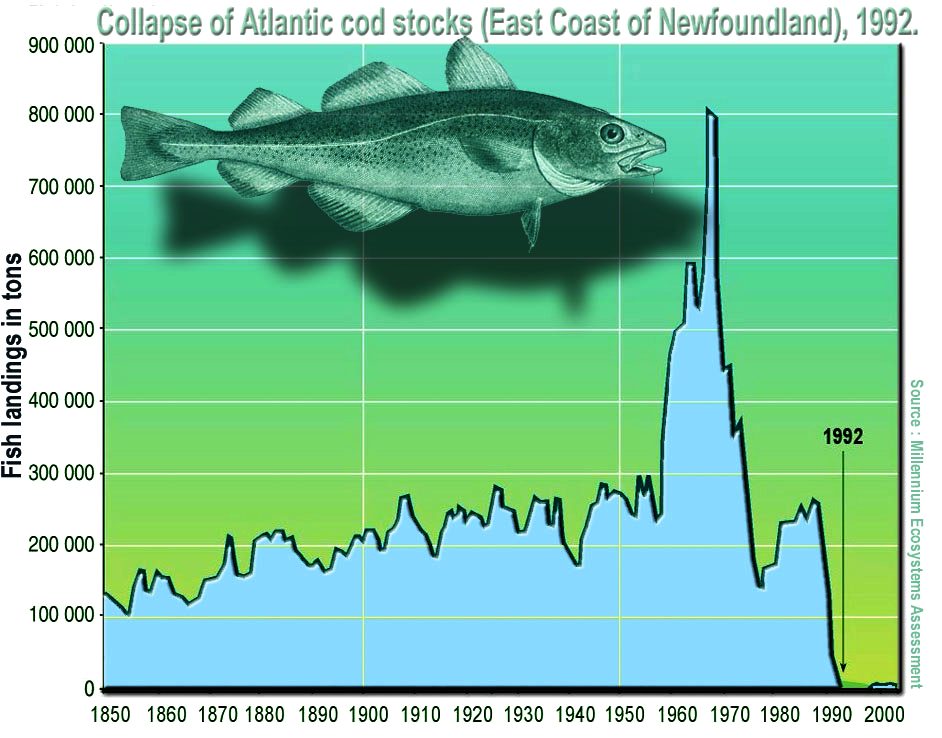
RESULT
OF OVERFISHING - Atlantic cod stocks were severely overfished in the 1970s and 1980s, leading to their abrupt collapse in 1992.
This is a lesson to all fishermen to take only what the system
can comfortably afford. Waters that are polluted with toxic
plastics may well hinder recovery, apart from the fact that
toxic fish on our plates is unappealing.
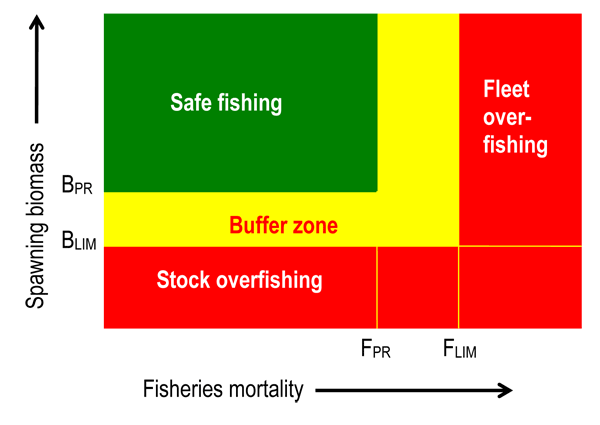
DEFINING
ACCEPTABLE LEVELS - The Traffic Light colour convention, showing the concept of Harvest Control Rule (HCR), specifying when a rebuilding plan is mandatory in terms of precautionary and limit reference points for spawning biomass and fishing mortality rate.
The notion of overfishing hinges on what is meant by an acceptable level of fishing. More precise biological and bioeconomic terms define acceptable level as follows:
1. Biological overfishing occurs when fishing mortality has reached a level where the stock biomass has negative marginal growth (reduced rate of biomass growth), as indicated by the red area in the figure. (Fish are being taken out of the water so quickly that the replenishment of stock by breeding slows down. If the replenishment continues to diminish for long enough, replenishment will go into reverse and the population will decrease.)
2. Economic or bioeconomic overfishing additionally considers the cost of fishing when determining acceptable catches. Under this framework, a fishery is considered to be overfished when catches exceed maximum economic yield where resource rent is at its maximum. Fish are being removed from the fishery so quickly that the profitability of the fishery is sub-optimal. A more dynamic definition of economic overfishing also considers the present value of the fishery using a relevant discount rate to maximise the flow of resource rent over all future catches.
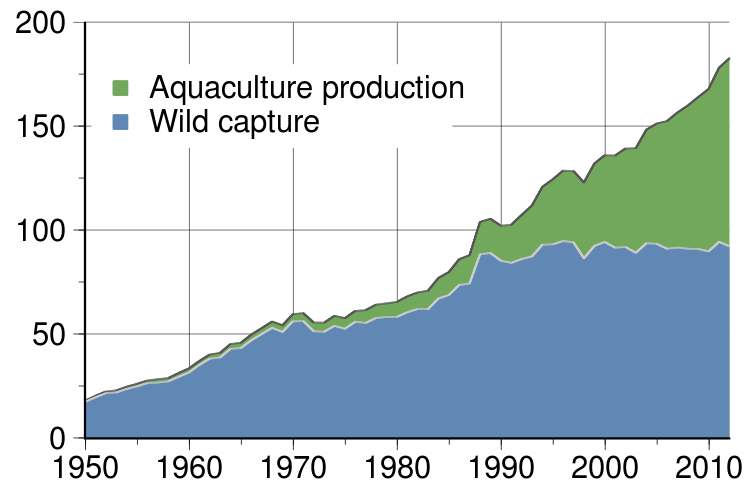
RISE
IN AQUACULTURE
PRODUCTION - Global harvest of aquatic organisms in million tonnes, 1950–2010, as reported by the FAO.
Clearly, as wild fish stocks are declining farmed fish
production is rising to fill the void. Current fishing methods
need to be revised to reduce bycatch using more selective
means.
THE
CONSEQUENCES OF OVER FISHING
According to a 2008
UN report, the world's fishing fleets are losing
US$50
billion each year through depleted stocks and poor fisheries management. The report, produced jointly by the World Bank and the
UN Food and Agriculture Organization (FAO), asserts that half the world's fishing fleet could be scrapped with no change in catch. In addition, the biomass of global
fish stocks have been allowed to run down to the point where it is no longer possible to catch the amount of fish that could be
caught
Increased incidence of schistosomiasis in
Africa has been linked to declines of fish species that eat the snails carrying the disease-causing parasites. Massive growth of jellyfish populations threaten fish stocks, as they compete with fish for food, eat fish eggs, and poison or swarm fish, and can survive in oxygen depleted environments where fish cannot; they wreak massive havoc on commercial fisheries.
Overfishing eliminates a major
jellyfish competitor and predator exacerbating the jellyfish population explosion. Both climate change and a restructuring of the ecosystem have been found to be major roles in an increase in jellyfish population in the Irish Sea in the 1990s.
GLOBAL
OVERFISHING
Overfishing has significantly affected many fisheries around the world. As much as 85% of the world's fisheries may be over-exploited, depleted, fully exploited or in recovery from exploitation. Significant overfishing has been observed in pre-industrial times. In particular, the overfishing of the western
Atlantic Ocean from the earliest days of European colonisation of the Americas has been well documented. Following World War
Two, industrial fishing rapidly expanded with rapid increases in worldwide fishing catches. However, many fisheries have either collapsed or degraded to a point where increased catches are no longer possible.
REMOVAL
OF SUBSIDIES
Several scientists have called for an end to subsidies paid to deep sea fisheries. In international waters beyond the 200 nautical mile exclusive economic zones of coastal countries, many fisheries are unregulated, and fishing fleets plunder the depths with state-of-the-art technology. In a few hours, massive nets weighing up to 15 tons, dragged along the bottom by deep-water trawlers, can destroy deep-sea
corals and sponge beds that have taken centuries or millennia to grow. The trawlers can target orange roughy, grenadiers, or sharks. These fish are usually long-lived and late maturing, and their populations take decades, even centuries to recover.
Fisheries scientist Daniel Pauly and economist
Ussif Rashid Sumaila have examined subsidies paid to bottom trawl fleets around the world. They found that US$152 million per year are paid to deep-sea fisheries. Without these subsidies, global deep-sea fisheries would operate at a loss of $50
million a year. A great deal of the subsidies paid to deep-sea trawlers is to subsidize the large amount of fuel required to travel beyond the 200-mile limit and drag weighted nets.
"There is surely a better way for governments to spend money than by paying subsidies to a fleet that burns 1.1 billion
litres of fuel annually to maintain paltry catches of old growth fish from highly vulnerable stocks, while destroying their habitat in the process" – Pauly.
"Eliminating global subsidies would render these fleets economically unviable and would relieve tremendous pressure on over-fishing and vulnerable deep-sea ecosystems" –
Sumaila.
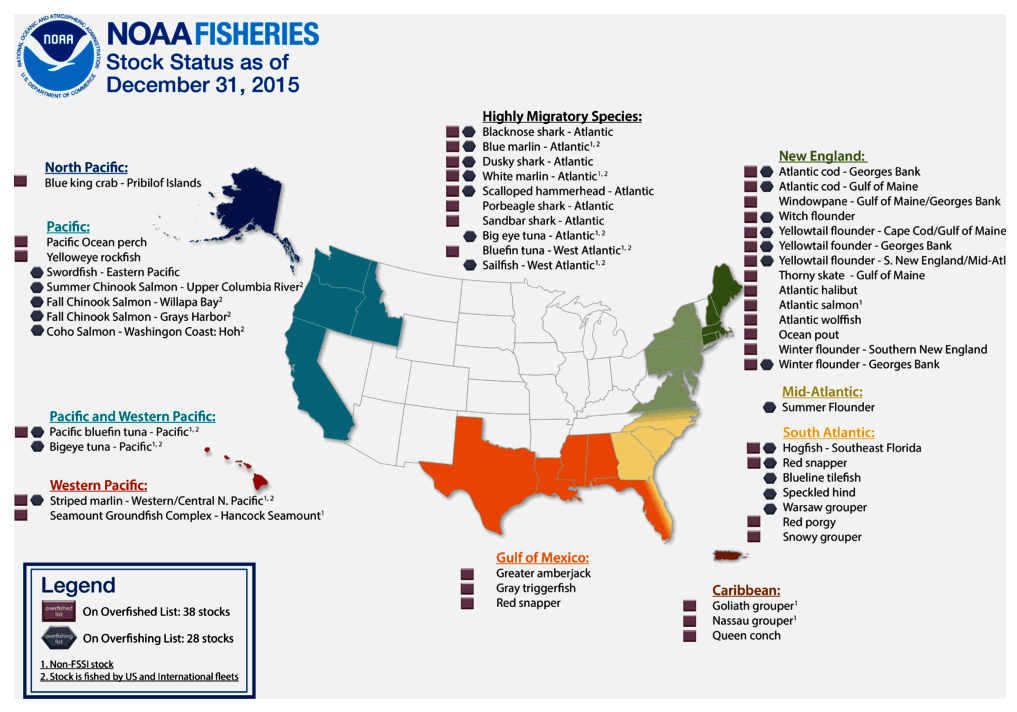
TRAWLER
CATCH - Overfished US stocks according to the NOAA in 2015.
It does not paint a pretty picture.
IS
IT POSSIBLE TO PREVENT OVER FISHING?
It
is almost impossible to prevent illegal catches even with the
rules for offshore fisherman and the quota system, and shore
catch limits for anglers. Examples of human ingenuity to get
around the law are:
1.
Bootlegging in the USA between 1919-33,
even with the likes of Elliot Ness and George Johnson, and
2.
Mad-Cow disease that looked set to infect UK herds when cattle
had to have passports to prove their origins.
The
main cause of over fishing remains giant
trawlers where it is only the larger ships that have the
capacity to take more than is needed locally. Hence, if we
were to place limits on fish imports and exports, that may
have the effect of keeping fishing more local and more
sustainable for the circular
economy the world is trying to achieve.
One
of the main problems with setting legal fishing limits is the
back-catch that is not monitored and so effectively amplifies
the over fishing problem. Many organizations have looked at
reducing bycatch and even offered
prizes for ideas.
Governments
around the world should work together to promote and support sustainable
fishing methods.
BARRIERS TO EFFECTIVE FISHERY MANAGEMENT
Where governments may create regulations to control what may
be taken from the sea, this can be undermined by illegal fishing activity. Estimates of the size of the illegal catch range from 11 to 26 million tonnes, which represents 14-33% of the world's reported catch. Illegal fishing can take many forms. In some developing countries, large numbers of poor people are dependent on fishing. It can prove difficult to regulate this kind of overfishing, especially for weak governments. Even in regulated environments, illegal fishing may occur. While industrial fishing is often effectively controlled, smaller scale and recreational fishermen can often break regulations such as bag limits and seasonal closures.
Fisherman can also easily fish illegally by doing things such as underreporting the amount of fish they caught or reporting that they caught one type of fish while actually catching another.
There is also a large problem with surveillance of illegal fishing activity. In 2001, the
UN Food and Agriculture Organization (FAO), passed the International Plan of Action to Prevent, Deter and Eliminate Illegal, Unreported and Unregulated Fishing (IPOA-IUU). This is an agreement with the intention to stop port states from allowing boats to dock that participated in illegal, unreported or unregulated fishing. It also gives details for port states on effective measures of inspecting and reporting illegal fishing. Some illegal fishing takes place on an industrial scale with financed commercial operations such as to be considered under the head of serious organised crime.
In waters that are the subject of territorial disputes, countries may actively encourage overfishing. A notable example is the cod wars where Britain used its navy to protect its trawlers fishing in Iceland's exclusive economic
zone. Fish are highly transitory. Many species will freely move through different jurisdictions. The conservation efforts of one country can then be exploited by another.
MITIGATION
With present and forecast world population levels it is not possible to solve the over fishing issue;[citation needed] however, there are mitigation measures that can save selected fisheries and forestall the collapse of others.
In order to meet the problems of overfishing, a precautionary approach and Harvest Control Rule (HCR) management principles have been introduced in the main fisheries around the world. The Traffic Light color convention introduces sets of rules based on predefined critical values, which could be adjusted as more information is gained.
The United Nations Convention on the Law of the Sea treaty deals with aspects of over fishing in articles 61, 62, and 65.
* Article 61 requires all coastal states to ensure that the maintenance of living resources in their exclusive economic zones is not endangered by over-exploitation. The same article addresses the maintenance or restoration of populations of species above levels at which their reproduction may become seriously threatened.
* Article 62 provides that coastal states: "shall promote the objective of optimum utilization of the living resources in the exclusive economic zone without prejudice to Article 61"
* Article 65 provides generally for the rights of, inter alia, coastal states to prohibit, limit, or regulate the exploitation of marine mammals.
According to some observers, overfishing can be viewed as an example of the tragedy of the commons; appropriate solutions would therefore promote property rights through, for instance, privatization and fish farming. Daniel K. Benjamin, in Fisheries are Classic Example of the "Tragedy of the Commons", cites research by Grafton, Squires and Fox to support the idea that privatization can solve the overfishing problem:
According to recent research on the British Columbia halibut fishery, where the commons has been at least partly privatized, substantial ecological and economic benefits have resulted. There is less damage to fish stocks, the fishing is safer, and fewer resources are needed to achieve a given harvest.
Another possible solution, at least for some areas, is quotas, so fishermen can only legally take a certain amount of fish. A more radical possibility is declaring certain areas of the sea "no-go zones" and make fishing there strictly illegal, so the fish in that area have time to recover and repopulate.
Controlling consumer behavior and demand is a key in mitigating action. Worldwide, a number of initiatives emerged to provide consumers with information regarding the conservation status of the seafood available to them.
GOOD
FISH GUIDE
You
can help to alleviate overfishing by voting with your buying
habits, that will be picked up by supermarkets
stocking programs and in turn will affect their purchasing
departments.
In
general make sure that farmed or fattened fish (aquaculture) the fish or shellfish should not be fed with endangered wild fish
and the farm should not be an ecological hazard via pollution
or the risk of fish escaping to the surrounding environment to
contaminate wild fish populations. As a rule of thumb locally caught or locally raised fish and shellfish is more sustainable than fish caught or raised far away in a different country.
There
are many good fish guides on the web. This one is just a
taster:
Africa,
South
Australia
Australia's
Sustainable Seafood Guide - Not free, only as book,
not accessible online. From the Australian Marine Conservation
Society.
Thanks
For All The Fish - Free. ABC Channel fish pages.
Based on the Australian Marine Conservation Societies guide.
Canada
SeaChoice
- A comprehensive national seafood program. List available
in PDF as well.
Hong
Kong
Live
Reef Food Fish - Online fish ID guide of live
reef food fish. By WWF Hong Kong.
Seafood
Guide - Fish and shellfish guide for Hong Kong.
By WWF Hong Kong.
Finland
Seafood
Guide - By WWF Finland. Direct link to PDF. (in
Finnish)
Indonesia
Seafood
Guide - Fish and shellfish guide for Indonesia. By WWF
Indonesia. In English and Indonesian.
Germany
WWF-Einkaufsratgeber
Fische & Meeresfruchte (seafood guide) - Annotated
purchasing guide. By WWF Germany. (in German)
Netherlands
& Belgium
De
Goede Vis Gids
One of the best guides available. By Stichting De
Noordzee. (in Dutch, French
version, pdf)
Vis-a-Card
Good fish guide by Greenpeace Nederland.
Printable credit card sized card. (in Dutch)
Norway
Sjømatguide
(Seafood guide, Norwegian) - By WWF Norway. Also a
printable credit card sized in PDF (in Norwegian).
Russia
Seafood
guide for Russia - By WWF Russia. Direct link to
printable credit card size PDF (in Russian).
Sweden
WWFs
Fiskguide – din guide när du ska köpa miljövänlig fisk
(seafood guide)
By WWF Sweden. Printable credit card sized in PDF
(in Swedish).
Switzerland
Seafood
Guide (German) - Guide in French,
German
and Italian.
By WWF Switzerland.
United
Kingdom
Pocket
fish purchasing guide - Extensive purchasing guide by
the Marine Conservation Society.
International
seafood red list - Illustrated what not to buy and
"better buys". By Greenpeace UK / International.
Good list with FAQ.
United
States of America
Monterey
Bay Aquarium Seafood Watch - Good list with
regional guides for five different US regions.
Guide
to Ocean Friendly Seafood - Informative site and
fish guides. By the Blue Ocean institute.
LINKS
& REFERENCE
http://overfishing.org/pages/guide_to_good_fish.php
http://overfishing.org/pages/guide_to_good_fish.php
http://www.seaaroundus.org/daniel-pauly-publications/
http://science.sciencemag.org/content/354/6309/185
https://en.wikipedia.org/wiki/Overfishing
https://www.gov.uk/government/organisations/marine-management-organisation
http://britishseafishing.co.uk/conservation/minimum-size-limits-for-shore-caught-fish/
http://britishseafishing.co.uk/sea-fishing-anglers-rights-and-the-magna-carta/
https://www.worldwildlife.org/threats/bycatch
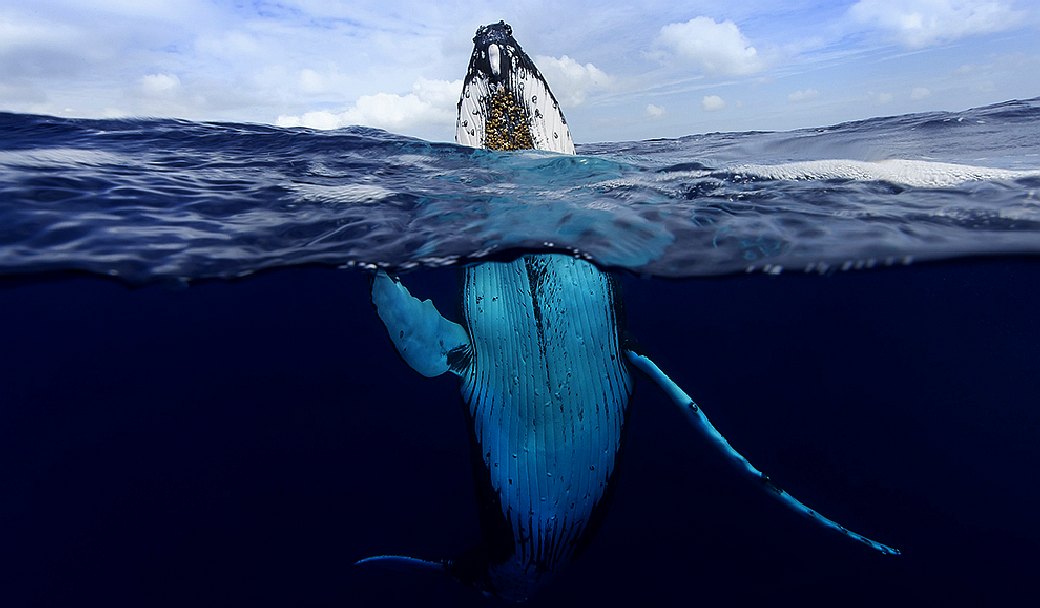
MARINE
LIFE - This humpback whale is one example of a magnificent
animal that is at the mercy of human
activity. Humans are for the most part unaware of the harm their fast-lane
lifestyles are causing. We aim to change that by doing all we
can to promote ocean
literacy.
Anchovies
| Bass
| Bream
| Catfish
| Clams
| Cod
Coley
| Crabs
| Crayfish
| Eels
| Grouper
| Haddock
| Hake
| Halibut
| Herring
| Jellyfish
Krill
| Lobster
| Mackerel
| Marlin
| Monkfish
| Mullet
| Mussels
| Oysters
| Perch
| Piranha |
Plaice
| Pollock
| Prawns
| Rays
| Sablefish
| Salmon
Sardines
| Scallops
| Sharks
| Shrimp
| Skate
| Sole
| Sprat
| Squid
| Sturgeon
| Swordfish
| Trout
| Tuna
| Turbot
| Whiting
This
website is provided on a free basis as a public information
service. Copyright © Cleaner
Oceans Foundation Ltd (COFL) (Company No: 4674774)
2022. Solar
Studios, BN271RF, United Kingdom.
COFL
is a charity without share capital.
|






